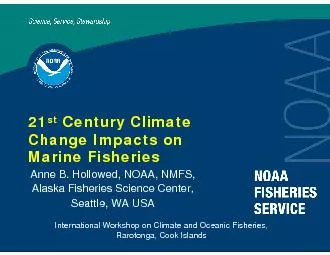/


4 127 Climate Precipitation change A1B 20802099 ID: 102616
Download Pdf The PPT/PDF document "climateprojectionsclimateoverestimate" is the property of its rightful owner. Permission is granted to download and print the materials on this web site for personal, non-commercial use only, and to display it on your personal computer provided you do not modify the materials and that you retain all copyright notices contained in the materials. By downloading content from our website, you accept the terms of this agreement.
4): 1-27 climateprojectionsclimateoverestimate Climate Precipitation change, A1B, 2080-2099 1980-1999Stippling in places where at least 80% of models agree on sign of changeMeehlet al., Chapter 10, IPCC AR4 WG1 Report Substantial Bias corrections and focusing on changes in features provide ways forward, but it improvements to approach, applied with caution! AOGCMs(Stock,shelfscaleclimateComputationalincreasegridrootedresolution(~1/81/4degree)AR5,most Regional NPZ-B-Lower trophic Regional Higher trophic conomic/ecological Landphysicsandhydrology OceanecologyBiogeochemistry Atmosphericcirculationradiation Interactive Oceancirculation Plantecologylanduse Ice Economic/ecological Regional Higher trophic Regional NPZ-B-Lower trophic Economic/ecological Regional Higher trophic Regional NPZ-B-Lower trophic Shifting zoogeographic distributions Shifting zoogeographic distributions PhenologyPhenologymismisChanging vital rates (growth, mortality, maturity Changing vital rates (growth, mortality, maturity bution, food habits))prey, competition)prey, competition) WassmannWassmannOceanogrOceanogr MaySea icePhytoplankton Bloom Sea iceMayIce algaeIce algaePhytoplankton Bloom StratificationBASIS SurveyTemperature Example of Current Environmental Tolerances: Eastern Bering Sea Forage Fish, Hollowed et al. In Review, DSR Cold years 2006-2009 Warm years (2004-2005) Age 0 pollock Age-1 pollock Capelin Additive Model predicted spatial surfaces of fish density.solid lines are 50m and 100m downscaled to local regions and ecosystem downscaled to local regions and ecosystem indicators incorporated into stock projection indicators incorporated into stock projection Dynamical downscaling: IPCC scenarios Dynamical downscaling: IPCC scenarios Fully coupled bioFully coupled biotime and space scales relevant to coastal time and space scales relevant to coastal Qualitative Vulnerability AssessmentQualitative Vulnerability Assessmentand capture fisheries: potential impacts adaptation and capture fisheries: potential impacts adaptation Elements FisheriesOceanography Management Demand for Fisheries Enhancement Forecast Downscaled 15 19601970198019902000 -2-10123 Year recruitment Age-structured Management Modified from Amaret al. 2009, IJMS 16 19601970198019902000 -2-10123 Year recruitment Age-structured Management Modified from Amaret al. 2009, IJMS Climate variability GOA pollockspawning biomass Amaret al. 2009 ICES J. Mar. Sci. 20102020203020402050 0.00.10.20.30.40.5 ccsm31YearSpawning biomass (million mt) 20102020203020402050 0.00.10.20.30.40.5 gfdl201YearSpawning biomass (million mt) 20102020203020402050 0.00.10.20.30.40.5 gfdl211YearSpawning biomass (million mt) 20102020203020402050 0.00.10.20.30.40.5 mirocH1YearSpawning biomass (million mt) 20102020203020402050 0.00.10.20.30.40.5 mirocM1YearSpawning biomass (million mt) 20102020203020402050 0.00.10.20.30.40.5 mirocM2YearSpawning biomass (million mt) 20102020203020402050 0.00.10.20.30.40.5 mirocM3YearSpawning biomass (million mt) 20102020203020402050 0.00.10.20.30.40.5 ukhadcm31YearSpawning biomass (million mt) SB pollockrecruitment 789101112 67891011 Summer SST Mueteret al. (ICES Journal of Marine Science 68(6) 19 1.Select models that perform well in region (9 models)2.Select scenarios: B1(low), A1B (intermediate) and A2 3.Create 82 SST scenarios4.Apply SST to recruitment mechanism to create future production scenarios.Ianelliet al. ICES Journal of Marine Science 68(6) EBS Walleye Pollock Spawning BiomassSSTs based on 82 climate-change scenarios NPZ Models withTrackinghappiness 21 LarvaeEnergy BudgetslarvaladultHabitatHydrodynamicEcosystemfield, ModelsEnd) Hufnagland Peck ICES Journal Marine Science 68(6) 22 FEAST Higher trophic NPZ-B-DLower trophic Oceanography Economic/ecological Climate scenarios BSIERP Observational Data Nested Statistical Projection BioenergeticFood-web#Species0 Multispeciesor single species1-10 Bottom up with dominant 100s Bottom up and top down with dominant fish and fisheriesEcosystem FeedbacksOne WayOne way (some two way)One wayTwo wayBiological RealismMinimally realisticModerately realisticMinimal w/Ecosystem feedbacksReasonably realisticComputational RequirementsModerateHighModerateVery highCapability to Sensitivity Analyses to Track Sources HighModerateModerateLowTreatment of ExcellentModerateModerateMinimal Aquaculture ~ 40 Aquaculture ~ 40 consumed.consumed.Rice and Garcia (ICES Journal Marine Science 68(6) 25 marineecological(PerryBarangeetglobal GCOMS (Global Coastal Ocean Modelling System). Model components:POL-Coastal Ocean Modelling SystemERSEM (European Regional Seas Ecosystem 1/10Includes important shelf processes: Tides, upwelling, Benthic/pelagic recyclingGeographically linked to LME : ocean governance Although global, the models Development of Regional Shelf Seas Barangeet al. 2010 2012 SICCMEAnalysis SynthesisReporting EarthSystemAnalysis Symposiumvolume Symposium Symposium Symposiumvolume SICCMESynthesisComparativeResearch EarthSystemAnalysis SICCMEUpdate SICCMESynthesisComparativeResearch Symposiumvolume201320142016 Symposium orkshopWorkshop Dimensions Synthesis SynthesisReportingWorkshopHemisphereSimulation Simulation SICCMEAnalysisMonitoringProgram MonitoringProgram Models have inherent strengths and weaknessesModels have inherent strengths and weaknessesrrently under development.rrently under development.s may be computationally too s may be computationally too eworks is needed and will eworks is needed and will require integration of stakrequire integration of stakA global perspective is needed to project longA global perspective is needed to project longterm term trends in fisheries. trends in fisheries. Coordinated monitoring and assessment needed to Coordinated monitoring and assessment needed to support global models. support global models. be communicatedbe communicated International Workshop on Climate and Oceanic Fisheries, Rarotonga, Cook IslandsAnne B. Hollowed, NOAA, NMFS, Alaska Fisheries Science Center,